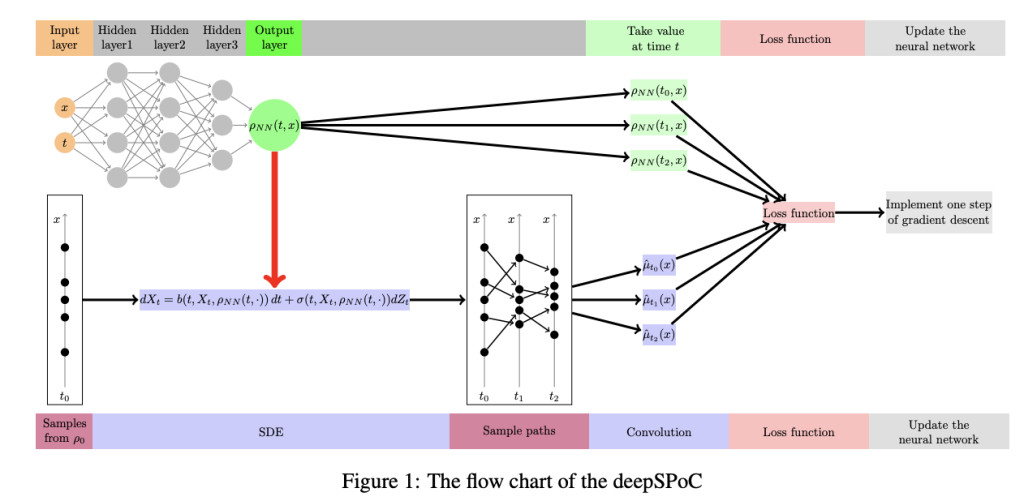Sequential Propagation of Chaos (SPoC) is a recent technique for solving mean-field stochastic differential equations (SDEs) and their associated nonlinear Fokker-Planck equations. These equations describe the evolution of probability distributions influenced by random noise and are vital in fields like fluid dynamics and biology. Traditional methods for solving these PDEs face challenges due to their non-linearity and high dimensionality. Particle methods, which approximate solutions using interacting particles, offer advantages over mesh-based methods but are computationally intensive and storage-heavy. Recent advancements in deep learning, such as physics-informed neural networks, provide a promising alternative. The question arises as to whether combining particle methods with deep learning could address their respective limitations.
Researchers from the Shanghai Center for Mathematical Sciences and the Chinese Academy of Sciences have developed a new method called deepSPoC, which integrates SPoC with deep learning. This approach utilizes neural networks, such as fully connected networks and normalizing flows, to fit the empirical distribution of particles, thus eliminating the need to store large particle trajectories. The deepSPoC method improves accuracy and efficiency for high-dimensional problems by adapting spatially and using an iterative batch simulation approach. Theoretical analysis confirms its convergence and error estimation. The study demonstrates deepSPoC’s effectiveness on various mean-field equations, highlighting its advantages in memory savings, computational flexibility, and applicability to high-dimensional problems.
The deepSPoC algorithm enhances the SPoC method by integrating deep learning techniques. It approximates the solution to mean-field SDEs by using neural networks to model the time-dependent density function of an interacting particle system. DeepSPoC involves simulating particle dynamics with an SDE solver, computing empirical measures, and refining neural network parameters via gradient descent based on a loss function. Neural networks can be either fully connected or normalizing flows, with respective loss functions of L^2-distance or KL-divergence. This approach improves scalability and efficiency in solving complex partial differential equations.
The theoretical analysis of the deepSPoC algorithm first examines its convergence properties when using Fourier basis functions to approximate density functions rather than neural networks. This involves rectifying the approximations to ensure they are valid probability density functions. The analysis shows that with sufficiently large Fourier basis functions, the approximated density closely matches the true density, and the algorithm’s convergence can be rigorously proven. Additionally, the analysis includes posterior error estimation, demonstrating how close the numerical solution is to the true solution by comparing the solution density against the exact one, using metrics like Wasserstein distance and Hα.
The study evaluates the deepSPoC algorithm through various numerical experiments involving mean-field SDEs with different spatial dimensions and forms of b and sigma. The researchers test deepSPoC on porous medium equations (PMEs) of multiple sizes, including 1D, 3D, 5D, 6D, and 8D, comparing its performance to deterministic particle methods and using fully connected neural networks and normalizing flows. Results demonstrate that deepSPoC effectively handles these equations, improving accuracy over time and addressing high-dimensional problems with reasonable precision. The experiments also include solving Keller-Segel equations leveraging properties of the solutions to validate the algorithm’s effectiveness.
In conclusion, An algorithmic framework for solving nonlinear Fokker-Planck equations is introduced, utilizing fully connected networks, KRnet, and various loss functions. The effectiveness of this framework is demonstrated through different numerical examples, with theoretical proof of convergence using Fourier basis functions. Posterior error estimation is analyzed, showing that the adaptive method improves accuracy and efficiency for high-dimensional problems. Future work aims to extend this framework to more complex equations, such as nonlinear Vlasov-Poisson-Fokker-Planck equations, and to conduct further theoretical analysis on network architecture and loss functions. Additionally, deepSPoC, which combines SPoC with deep learning, is proposed and tested on various mean-field equations.
Check out the Paper. All credit for this research goes to the researchers of this project. Also, don’t forget to follow us on Twitter and LinkedIn. Join our Telegram Channel. If you like our work, you will love our newsletter..
Don’t Forget to join our 50k+ ML SubReddit
The post DeepSPoC: Integrating Sequential Propagation of Chaos with Deep Learning for Efficient Solutions of Mean-Field Stochastic Differential Equations appeared first on MarkTechPost.
Source: Read MoreÂ


